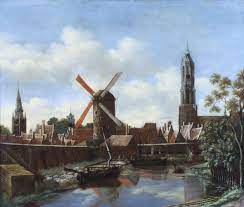In 1650, the most developed country in Europe was the Dutch Republic, not England. High living standards were accompanied and supported by unprecedented urbanization and agricultural productivity. 2/ 

Some associate the 17th c. "Dutch Golden Age" with the carrying trade, but while commerce provided some capital, the Netherlands really grew because of industry—it exported a wide range of manufactured goods, from finished textiles and sawn timber to beer and refined sugar. 3/
Dutch industry was extremely energy-intensive: to blow glass, refine salt, make bricks, and bake bread, you need heat. Most countries used some combination of wood/charcoal and coal. But the Dutch, having cut down their forests by 1640, had neither. 4/
Peat forms in marshy areas when plant matter fails to fully decay due to a lack of oxygen. It's an intermediate stage in the formation of coal and has a little more than half the energy density. So you can burn it as a fossil fuel. 6/ 

Dutch peat was also close to the water table, so it was relatively cheap to build connector canals between waterways and "peateries." This was crucial, as peat is bulkier than charcoal or coal. 7/ 

Initial peat extraction in the Low Countries began in Flanders in the 12th and 13th centuries, supplying Bruges, Ghent and Ypres, but as the coastal Belgian bogs ran out, Holland took over, exporting to Antwerp. 8/ 

By 1530, reserves in Holland and Utrecht were dwindling, partly because existing techniques required diggers to harvest only the top layer (of 4.5m) to prevent flooding. 9/
In response, the Dutch invented the "baggerbeugel," a dredging net on a long pole. Using the "slagturven" method, diggers stood on boats and pulled up peat from below the waterline. (this intensification actually caused land to sink, but the Dutch were skilled at pumping). 10/ 

Holland still couldn't satisfy urban demand, however, so areas in Groningen, Friesland, and Drenthe—higher elevation—were exploited after 1580. Digging in the "hoogveen" required capital investment in canals, and was thus conducted by large investor consortia from the cities. 11/ 

All this did come at a cost to farming (by flooding land), contributing to the Dutch need for food imports. But this sacrifice made the Dutch Europe's most energy-intensive society—getting two times the output of British coal during the mid-17th century, by one estimate. 12/ 

Cheap energy became the basis of the Golden Age Dutch economy, making Dutch exports exceptionally low-cost and raising wages. The high wage-cheap energy/capital combination (sound familiar?) encourage labor-saving through invention and K/L substitution. 13/
Peat was used everywhere: salt pans, beer breweries, sugar refineries, shipbuilding, distilleries, cloth finishing, dyeworks, bakeries, and forges. Industries became increasingly concentrated in locations with easy water access, increasing urbanization. 14/ 

During the seventeenth century, the Dutch Republic was the richest and most urbanized country on earth. But after 1650/70, the gap with England started to close. 15/
Part of this was inevitable catch-up growth: the Dutch had the world's best, lowest-cost techniques in construction, milling, and manufacturing, which were highly sought across Europe. Rival powers attracted Dutch engineers, adopted Dutch methods, and seized Dutch markets. 16/
At the same time, however, the Dutch began to run out of peat. Output dramatically slowed during the 1660s (by 20 percent) and prices rose as energy demand outran supply. Since peat stores were being depleted at a peak rate of 3-5% per year, this was inevitable. 17/
By 1750, per capita energy use had fallen by 15-20 percent. GDP per head was no higher, and urbanization and agricultural productivity were lower. Was this the first great energy crisis of an early modern "advanced agrarian economy," as suggested by Wrigley? 18/ 

I'm skeptical. While the Dutch may have lacked domestic energy sources, they could import coal—the *same* Tyneside coal that London used—by sea. After all, it's not appreciably harder to ship coal from Newcastle to the Thames than to the Dutch coast. 19/ 

Even during the 17th century, the Dutch were importing significant amounts of British coal, which was available in Amsterdam at comparable prices to London. In 1800, coal supplied the same power that peat had in 1660. 20/
I suggest that the story is demand-side: a stagnating economy lowered energy consumption, not a supply bottleneck. Had the Golden Age persisted, alternative sources would have been found. 21/
All this and more is detailed in this week's newsletter, which you can check out here: daviskedrosky.substack.com/p/peats-cradle
• • •
Missing some Tweet in this thread? You can try to
force a refresh





















